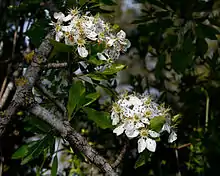Pyrus syriaca
Pyrus syriaca is a deciduous tree in the Rosaceae family.[2][3] It is referred to by the common name Syrian pear. It is the only pear species which grows in the wild in Lebanon,[4] Turkey, Syria and Israel.
| Pyrus syriaca | |
|---|---|
 | |
| Scientific classification | |
| Kingdom: | Plantae |
| Clade: | Tracheophytes |
| Clade: | Angiosperms |
| Clade: | Eudicots |
| Clade: | Rosids |
| Order: | Rosales |
| Family: | Rosaceae |
| Genus: | Pyrus |
| Species: | P. syriaca |
| Binomial name | |
| Pyrus syriaca | |
| Synonyms[2] | |
|
Pyrus boveana Decne. | |
The Syrian pear is a protected plant in Israel. It grows in unsalted ground, usually in Mediterranean scrub, in west Syria, in the Galilee and the Golan.
In the months of March and April, the tree blossoms with white flowers. The fruit ripen in the autumn in the months of September and October. The fruit is edible, though not as good as the European Pear, mostly because of hard, stone like objects found in the skin. The ripe fruit falls to the ground and when it starts to rot, the smell attracts wild boars. The boars eat the fruit and distribute the seeds.
References
- Wilson, B. (2018). "Pyrus syriaca". IUCN Red List of Threatened Species. 2018: e.T173016A61613968. doi:10.2305/IUCN.UK.2018-2.RLTS.T173016A61613968.en. Retrieved September 7, 2020.
- "Pyrus syriaca Boiss". Plants of the World Online. The Trustees of the Royal Botanic Gardens, Kew. n.d. Retrieved September 7, 2020.
- "Pyrus syriaca Boiss". World Flora Online. The World Flora Online Consortium. n.d. Retrieved September 7, 2020.
- Tohmé, Georges and Henriette (2014). Illustrated Flora of Lebanon. Lebanon: National Council for Scientific Research, Lebanon. p. 531. ISBN 9789953028903.
External links
- Pyrus syriaca Israel native plants
 Media related to Pyrus syriaca at Wikimedia Commons
Media related to Pyrus syriaca at Wikimedia Commons Data related to Pyrus syriaca at Wikispecies
Data related to Pyrus syriaca at Wikispecies
